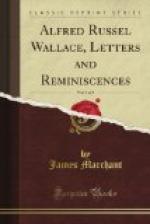From a communication received from the Royal Geographical Society it appears that the first complete survey of this river (a compass traverse supplemented by astronomical observations) was made (1907-8) by Dr. Hamilton Rice, starting from the side of Colombia, and tracing the whole course of the river from a point near the source of its head-stream. The result showed that the general course of the lower river was much as represented by Wallace, though considerable corrections were necessary both in latitude and longitude. “I am assured by authorities on the Rio Negro region,” writes Dr. Scott Keltie to Mr. W.G. Wallace, under date May 21, 1915, “that your father’s work still holds good.”
In May, 1852, Wallace returned to Para, and sailed for England the following July. The ship took fire at sea, and all his treasures (not previously sent to England) were unhappily lost. Ten days and nights were spent in an open boat before another vessel picked them up, and in describing this terrible experience he says: “When the danger appeared past I began to feel the greatness of my loss. With what pleasure had I looked upon every rare and curious insect I had added to my collection! How many times, when almost overcome by the ague, had I crawled into the forest and been rewarded by some unknown and beautiful species! How many places, which no European foot but my own had trodden, would have been recalled to my memory by the rare birds and insects they had furnished to my collection! How many weary days and weeks had I passed, upheld only by the fond hope of bringing home many new and beautiful forms from these wild regions ... which would prove that I had not wasted the advantage I had enjoyed, and would give me occupation and amusement for many years to come! And now ... I had not one specimen to illustrate the unknown lands I had trod, or to call back the recollection of the wild scenes I had beheld! But such regrets were vain ... and I tried to occupy myself with the state of things which actually existed."[7]
On reaching London, Wallace took a house in Upper Albany Street, where his mother and his married sister (Mrs. Sims), with her husband, a photographer, came to live with him. The next eighteen months were fully occupied with sorting and arranging such collections as had previously reached England; writing his book of travels up the Amazon and Rio Negro (published in the autumn of 1853), and a little book on the palm trees based on a number of fine pencil sketches he had preserved in a tin box, the only thing saved from the wreck.
In summing up the most vivid impressions left on his mind, apart from purely scientific results, after his four years in South America, he wrote that the feature which he could never think of without delight was “the wonderful variety and exquisite beauty of the butterflies and birds ... ever new and beautiful, strange and even mysterious,” so that he could “hardly recall them without a thrill of admiration




